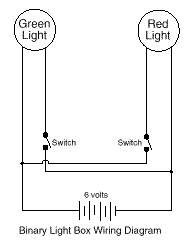4. For the practice columns, total up the numbers each sequential flash represents. For example, if all flashes are red, the value is 0+0+0+0+0+0 = 0. If six green lights flash in a row, the value of the binary number is 63. The first green flash represents a 1, the second is 2, the third is 4, the fourth is 8, the fifth is 16, and the sixth is 32 (1+2+4+8+16+32=63). The following sequence of flashes is 37: Green, Red, Green, Red, Red, Green.
5. After the students become familiar with the method, transmit a message to the them. Create the message by referring to the substitution code in the following pages. Replace each word in your message with the corresponding code number. For example, "Hello!" would convert to 7, 4, 11, 11, 24, 38. Next, convert each code number into a binary number. Seven, for example, becomes Green, Green, Green, Red, Red, Red and 24 becomes Red, Red, Red, Green, Green, Red. As you will note in the substitution code, only the first 40 of the 64 possible numbers are used. The remaining numbers can be assigned to common words of your choosing such as "the" and "but," and to short sentences such as "How are you?" Transmit the message by flashing the lights in the proper sequence. Every six flashes represents a binary number that can be converted into a letter or word through the code. Students receive the message by checking the flashes on the data sheet, determining the binary numbers they represent, and then changing the numbers into letters or words.
6. Discuss how a picture could be translated through binary code. (Refer to the activity Paint By The Number.)

Discussion:
Because astronomical spacecraft operate in orbit around Earth, the images they collect of objects in space have to be transmitted to the ground by radio signals. To make this possible, the light from distant objects is concentrated on a light sensitive charged coupled device (CCD). The Hubble Space Telescope uses four CCD's arranged in a square. The surface of each CCD is a grid consisting of 800 vertical and 800 horizontal lines that create a total of 640,000 light sensitive squares called pixels for picture elements. With four CCDs, the total number of pixels in the Hubble Space Telescope CCD array is 2,360,000.
Photons of light, coming from a distant object, fall on the CCD array and are converted into digital computer data. A numerical value is assigned to the number of photons received on each of the more than two million pixels. This number represents the brightness of the light falling on each pixel. The numbers range from 0 to